人教版Book6 Unit5 语法--ving作状语导学案
- 格式:doc
- 大小:47.50 KB
- 文档页数:5
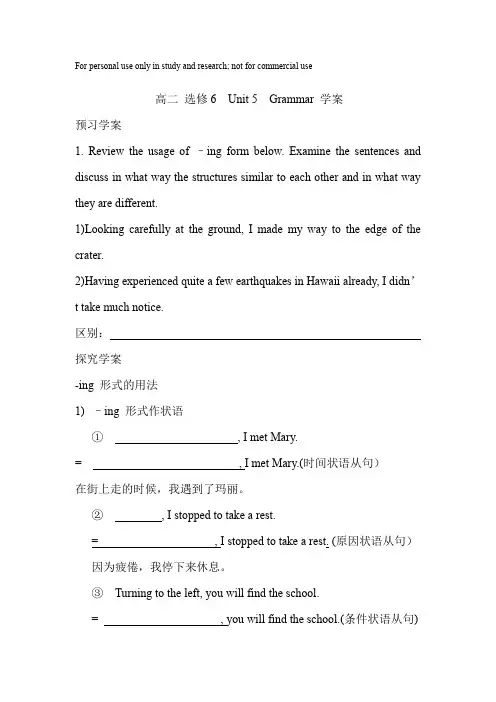
For personal use only in study and research; not for commercial use高二选修6 Unit 5 Grammar 学案预习学案1. Review the usage of –ing form below. Examine the sentences and discuss in what way the structures similar to each other and in what way they are different.1)Looking carefully at the ground, I made my way to the edge of the crater.2)Having experienced quite a few earthquakes in Hawaii already, I didn’t take much notice.区别:探究学案-ing 形式的用法1)–ing 形式作状语①, I met Mary.= , I met Mary.(时间状语从句)在街上走的时候,我遇到了玛丽。
②, I stopped to take a rest.= , I stopped to take a rest. (原因状语从句)因为疲倦,我停下来休息。
③Turning to the left, you will find the school.= , you will find the school.(条件状语从句)向左走,你就会找到那个学校。
④Knowing where I live, he never come to see me .= , he never comes to see me. (让步状语从句)尽管他知道我的住处,但从不来看我。
2)–ing形式的完成式Having +p.p. …, 主语+谓语(Having been) +p.p. …, 主语+谓语–ing形式的完成式所表示的时间在谓语动词之前表示被动可直接用过去分词⑤, I went home.= , I went home。
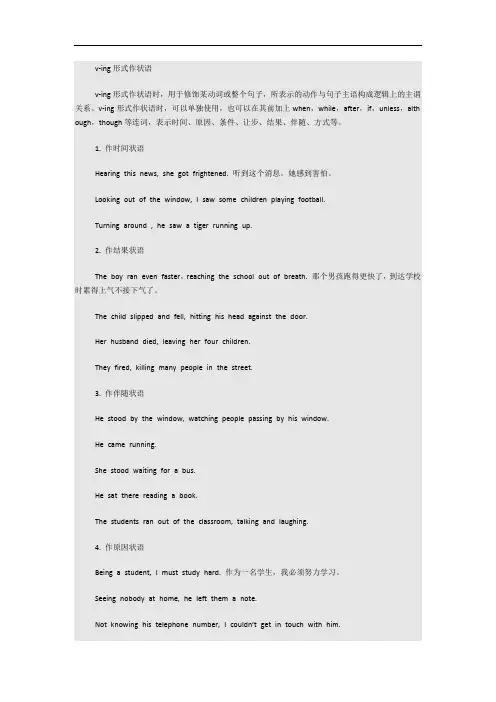
v-ing形式作状语v-ing形式作状语时,用于修饰某动词或整个句子,所表示的动作与句子主语构成逻辑上的主谓关系。
v-ing形式作状语时,可以单独使用,也可以在其前加上when,while,after,if,unless,alth ough,though等连词,表示时间、原因、条件、让步、结果、伴随、方式等。
1. 作时间状语Hearing this news, she got frightened. 听到这个消息,她感到害怕。
Looking out of the window, I saw some children playing football.Turning around , he saw a tiger running up.2. 作结果状语The boy ran even faster,reaching the school out of breath. 那个男孩跑得更快了,到达学校时累得上气不接下气了。
The child slipped and fell, hitting his head against the door.Her husband died, leaving her four children.They fired, killing many people in the street.3. 作伴随状语He stood by the window, watching people passing by his window.He came running.She stood waiting for a bus.He sat there reading a book.The students ran out of the classroom, talking and laughing.4. 作原因状语Being a student, I must study hard. 作为一名学生,我必须努力学习。
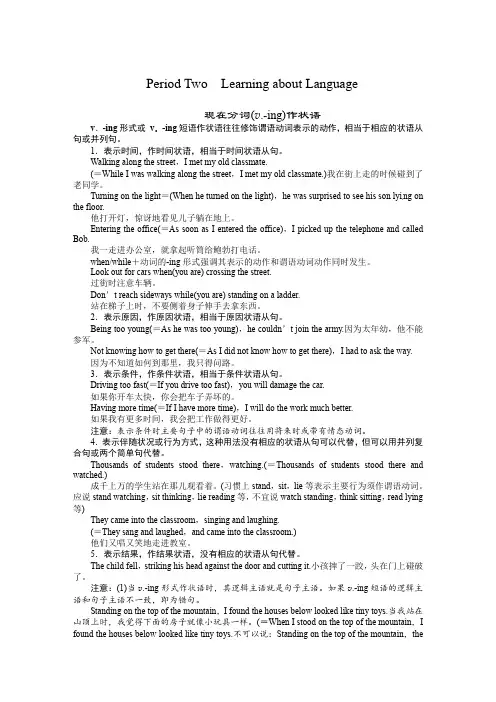
Period Two Learning about Language现在分词(v.-ing)作状语v.-ing形式或v.-ing短语作状语往往修饰谓语动词表示的动作,相当于相应的状语从句或并列句。
1.表示时间,作时间状语,相当于时间状语从句。
Walking along the street,I met my old classmate.(=While I was walking along the street,I met my old classmate.)我在街上走的时候碰到了老同学。
Turning on the light=(When he turned on the light),he was surprised to see his son lyi ng on the floor.他打开灯,惊讶地看见儿子躺在地上。
Entering the office(=As soon as I entered the office),I picked up the telephone and called Bob.我一走进办公室,就拿起听筒给鲍勃打电话。
when/while+动词的-ing形式强调其表示的动作和谓语动词动作同时发生。
Look out for cars when(you are) crossing the street.过街时注意车辆。
Don’t reach sideways while(you are) standing on a ladder.站在梯子上时,不要侧着身子伸手去拿东西。
2.表示原因,作原因状语,相当于原因状语从句。
Being too young(=As he was too young),he couldn’t join the army.因为太年幼,他不能参军。
Not knowing how to get there(=As I did not know how to get there),I had to ask the way.因为不知道如何到那里,我只得问路。
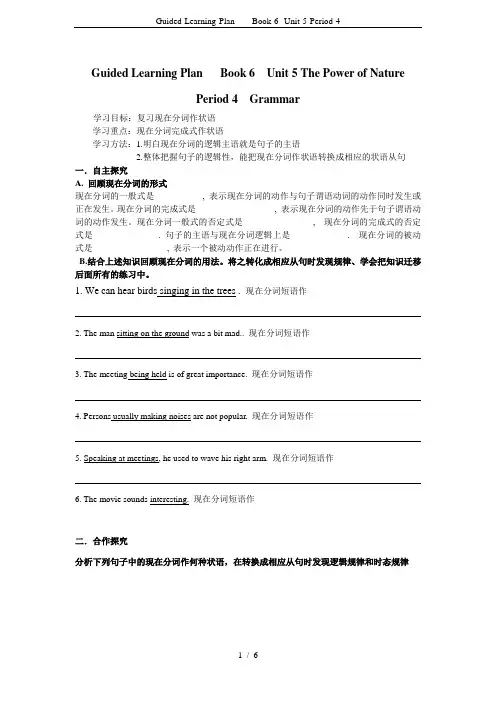
Guided Learning Plan Book 6 Unit 5 The Power of NaturePeriod 4 Grammar学习目标:复习现在分词作状语学习重点:现在分词完成式作状语学习方法:1.明白现在分词的逻辑主语就是句子的主语2.整体把握句子的逻辑性,能把现在分词作状语转换成相应的状语从句一.自主探究A. 回顾现在分词的形式现在分词的一般式是___________, 表示现在分词的动作与句子谓语动词的动作同时发生或正在发生。
现在分词的完成式是__________________, 表示现在分词的动作先于句子谓语动词的动作发生。
现在分词一般式的否定式是________________, 现在分词的完成式的否定式是_______________. 句子的主语与现在分词逻辑上是_____________. 现在分词的被动式是_________________, 表示一个被动动作正在进行。
B.结合上述知识回顾现在分词的用法。
将之转化成相应从句时发现规律、学会把知识迁移后面所有的练习中。
1. We can hear birds singing in the trees . 现在分词短语作_______________2. The man sitting on the ground was a bit mad.. 现在分词短语作_______________3. The meeting being held is of great importance. 现在分词短语作_______________4. Persons usually making noises are not popular. 现在分词短语作_______________5. Speaking at meetings, he used to wave his right arm. 现在分词短语作_______________6. The movie sounds interesting. 现在分词短语作______________________________________________________________________________________________ 二.合作探究分析下列句子中的现在分词作何种状语,在转换成相应从句时发现逻辑规律和时态规律C.反馈测试把下列句子改成简单句,用现在分词作状语1. Because I had experienced earthquakes before, I wasn’t frightened.2. As I came out of my house, I saw the volcano erupting.3. When she woke up in the middle of the night, she saw her room was as light as day.4. After we had stopped the car, we found ourselves in the fog and couldn’t see clear ahead.5. Because I had spent all night reading the documents, I was very tired the next day.6. As the child had never seen a rainbow before, he was very excited.7.As Tim was feeling exhausted, he went to bed as soon as he got home.8. When John watched the volcano erupt, he became worried about his safety.D.延伸拓展用所给词的正确的现在分词形式填空arrive rest take hear standAn Eyewitness Account of a Murder at Flat3, Southampton Gardens, London___________ at the party, I found all my friends were already there. The dancing was just beginning. ____________ there, I saw some of my friends chatting at a table. So I went over to join them. All this while I had not seen my hostess. ____________ a drink , I felt rather uncomfortable and got a headache. A maid took me upstairs to rest. It was about 10pm. _________________ for a while, I felt better and went to the balcony to have some fresh air. It was at that moment that I realized something was wrong. ______________ a scream, I rushed downstairs only to see my hostess lying unconscious on the floor, surrounded by her quests. She was shot.Unit5 Book6 grammar一.自主探究A. doing, having done, not doing , not having done,B. 1. 宾补We can hear birds are singing in the trees.2. 定语The man who was sitting on the ground was a bit mad.3.定语The meeting that is being held is of great importance.4. 定语Persons who usually make noises are not popular.5.状语When he spoke at meetings, he used to wave his right arm.6. 表语二.合作探究1.时间状语When/while he was standing….2. 原因状语Because/As he is a party member3. 伴随状语and was thinking what to do next.4. 方式状语We keep in touch with one another by using handsets.5. 条件状语If you Study hard6. 结果状语so they left him a large sum of money.7. 原因/时间状语Because/As/When the patient was being operated on8. 时间状语When she came in9. 让步状语Though the students had finished their schoolwork10. 让步状语Though he didn’t know where his son was11. 原因状语Because Martin had not taken the right bus12. 时间状语When she had given her opinion about protecting the environment,13. 原因状语As she had bought the precious necklace14. 原因状语As the novelist had spent all day indoors15. 原因状语As Mark had arrived early for his date16. 原因状语As she has passed the test.现在分词可作时间,条件,让步,方式,原因,结果,伴随状语为表示强调,除表示原因的连词because, as外,其它连词when, while, though, even if, if等可留下.C.反馈测试1, Having experienced earthquakes before2.(when)Coming out of my house3.( When )waking up in the middle of the night4. Having stopped the car5. Having spent all night reading the documents6. Having never seen a rainbow before7. Feeling exhausted8. (When )J watching the volcano eruptD.延伸拓展Arriving , standing, Having taken, Having rested, Hearing。
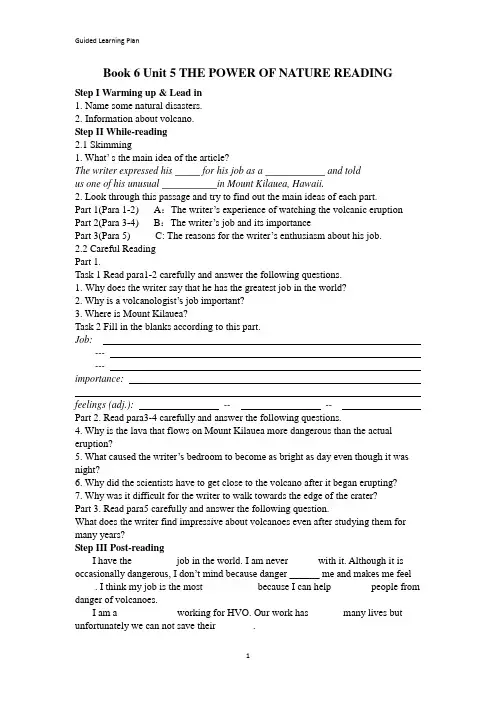
Book 6 Unit 5 THE POWER OF NATURE READINGStep I Warming up & Lead in some natural disasters.rmation about volcano.Step II While-reading2.1 Skimming1. What’ s the main idea of the article?The writer expressed his _____ for his job as a ____________ and toldus one of his unusual ___________in Mount Kilauea, Hawaii.2. Look through this passage and try to find out the main ideas of each part.Part 1(Para 1-2) A:The writer’s experience of watching the volcanic eruption Part 2(Para 3-4) B:The writer’s job and its importancePart 3(Para 5) C: The reasons for the writer’s enthusiasm about his job.2.2 Careful ReadingPart 1.Task 1 Read para1-2 carefully and answer the following questions.1.Why does the writer say that he has the greatest job in the world?2. Why is a volcanologist’s job important?3. Where is Mount Kilauea?Task 2 Fill in the blanks according to this part.Job:------importance:feelings (adj.): -- --Part 2. Read para3-4 carefully and answer the following questions.4. Why is the lava that flows on Mount Kilauea more dangerous than the actual eruption?5. What caused the writer’s bedroom to become as bright as day even though it was night?6. Why did the scientists have to get close to the volcano after it began erupting?7. Why was it difficult for the writer to walk towards the edge of the crater?Part 3. Read para5 carefully and answer the following question.What does the writer find impressive about volcanoes even after studying them for many years?Step III Post-readingI have the ________ job in the world. I am never _____ with it. Although it is occasionally dangerous, I don’t mind because danger ______ me and makes me feel ____. I think my job is the most __________ because I can help _______ people from danger of volcanoes.I am a ___________ working for HVO. Our work has ______ many lives but unfortunately we can not save their _______.I have ___________ a volcano eruption in Hawaii. I was ____ asleep when my bed began _______ and I heard a _______ sound, like a _____ passing nearby. Then I found my bedroom was as ______ as day, and red lava was ___________ hundreds of meters into the air. The next day, three of us wanted to get close to the ______. We put on _________ suits, ________, big _______ and special ______, which made us look like __________. We slowly _____________ to the edge of the crater to collect some _____ for __________. After studying volcanoes for many years, I am just as___________ about my job as before. Why? Because of their ________ and their_________ to cause great damage.Step IV DiscussionExercise 2&3 on p35HomeworkFinish exercises on Exercise Book ( Period 1 Unit 5)Important and Difficult Sentences1.However, the most important thing about my job is that I help protect ordinary people from one of the most powerful forces on earth–the volcano.1). My hope is ___ he will become a doctor in the future.A. ifB. whetherC. thatD. what2). Our village is no longer ____ over twenty years ago.A. what was itB. what it wasC. the village what wasD. what was the village2. Having collected and evaluated the information, I help other scientists to predict where lava from the volcano will flow next and how fast.3.This is because no one lives near the top of Mount Kilauea, where the rocks fall.1). That was ______ I was thirteen I entered the No. 1 Middle School.A. becauseB. whyC. how D when2). I shall never forget those years _____ I lived on the farm with the farmers, _____ has a great effect on my life.A. when; whoB. that; whichC. which; thatD. when; which4. I was about to go back to sleep when suddenly my bedroom became as bright as day.我正要出门去你家辅导你英语,这时我叔叔来了。
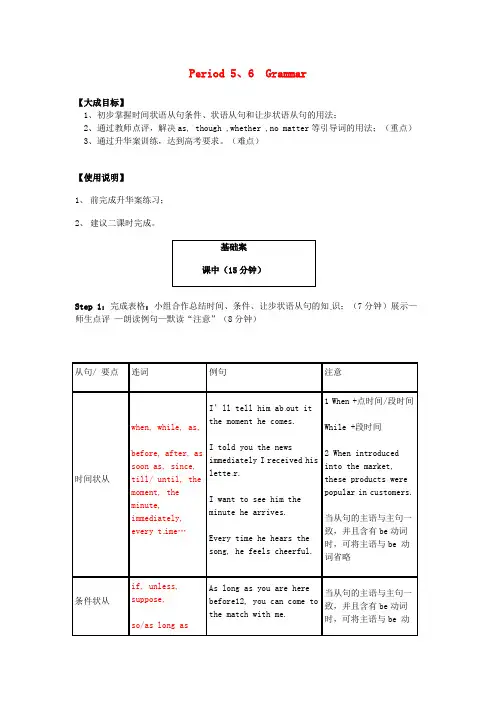
Period 5、6 Grammar【大成目标】1、初步掌握时间状语从句条件、状语从句和让步状语从句的用法;2、通过教师点评,解决as, though ,whether ,no matter等引导词的用法;(重点)3、通过升华案训练,达到高考要求。
(难点)【使用说明】1、前完成升华案练习;2、建议二课时完成。
Step 1:完成表格:小组合作总结时间、条件、让步状语从句的知识;(7分钟)展示—师生点评—朗读例句—默读“注意”(8分钟)when, while, as,before, after, as soon as, since, till/ until, the moment, the minute, immediately, every t ime…I’ll tell him ab out it lette r.Step3、Doing a quiz on adverbial clauseMutiple Choice:1.You like sports_____I’d like to read.A.when B.while C.but D.yet2. _____ we were singing, the teacher came in.A.Before B.after C.As D.Until3.I was about to leav e my house _____the phone rang. A.while B. when C.as D.after4.They did not stop fighting_____ ther e was no enemy left. A.until B.after C.when D.since5.I have not seen him_____ he went to college.A.when B.before C.as D.since6.It is five days_____ we came here.A.when B.before C.as D.since7.It was not long_____ he got to know it.A.when B.before C.after D.until8.We shall go_____we are free.A.whenever B.whatever C.wherever D.however9. _____I live I must serve the people heart and soul.A.When B.So long as C.As soon as D.On condition10.I was reading a novel_____ he was watching TV.A.when B.while C.before D.as11.Put the medicine_____you can easily get it.A.so that B.where C.which D.there12.We will go_____the Party wants us to go.A.wherever B.there C.to the place D.which13. _____ there is a will there is a way.A.When B.Where C.Whether D.How14.I am going_____ you went last week.A.where B.wherever C.when D.the place15. _____ you go , you should bear the motherland in your mind.A.Where B.Wherever C.Whatever D.However16. _____ weather permits, we’ll have an outing.A.For B.Though C.While D.If17.You won’t succeed_____harder.A.unless you will work B.unless you workC.unless you don’t work D.if you won’t work18.I wonder if he_____us, and I think if he_____us we’ll be able to complete the task ahead of time.A.helps, helps B.will help, helpsC.helps, will help D.will help, will help19.I don’t like to be interrupted if I_____.A.speak B.will speak C.am speaking D.spoke20.If you_____ this experiment you will understand the theory better.A.will be doing B.have done C.will have done D. would do21.I would like to do it_____I like it.A.since B.because C.because of D.now that22. _____everybody is here, Let’s set off.A.Since B.Because C.For D.After23.It was_____ he was ill that he was absent yesterday.A.because B.as C.since D.now that24. _____it is raining, we had better take a taxi.A.For B.As C.Be cause of D.When25.“Why can’t you do it now?” “_____I’m too bus y.”A.Since B.As C.Because D.For26.He must have passed this way, _____here are his footprints.A.since B.because of C.now that D.for27. _____everybody is here, Let’s begin our meeting.A.Now that B.Because C.For D.When28.His speech made_____deep impression on the audience that they could hardly forget it.A.such a B.so a C.so D.such29.They worked hard_____they finished their work ahead of time.A.so B.so that C.such that D.so as to30.He was_____weak_____ he couldn’t stand up.A.such, that B.so, that C.very, that D.so, as to31.The foreigner spoke_____ his interpreter could hardly catch his words. A.such fast that B.so fast C.so fast that D.so fastly that32.The book is_____ it gives a wrong idea of the facts.A.so writing that B.such written thatC.such writing that D.so written that33.The house cost_____ we didn’t buy it.A.so much money that B.so many money thatC.such much money that D.such many money that34.It is_____ all of us can do it.A.so easy exercise that B.such easy an exercise C.such easy exercise D.so easy an exercise that35.She has _____she remembers all the names of the students sheA.so good memory that B.such a good memory that C.such good memory that D.good memory36.They stopped at Tianjing_____they might visit the TV tower. A.so B.because C.so that D.in order37.We all got up early_____we might start at six.A.in order that B.in order to C.so D.so as to 38.Let the dog loose so that it_____ have a run.A.should B.must C.could D.need39. _____clearly so that your teacher_____ you correctly. A.Write, can understand B.Having written, can understand C.To write, could understand D.Writing, will understand 40.He started early s o that he_____ there in time.A.could getB.got C.had got D.would have got41. _____it was late , she went on working.A.Though B.Because C.Since D.Whether42. _____we fail , we _____trying.A.Even if , don’t st op B.Even though, won’t stop C.Even, will not stop D.Even although, shall never stop 43. _____ the pain was bad, _____he did not complain. A.Although, but B.Though, butC.Though, yet D.Even, still44. _____ physics, he likes maths better.A.As he much likes B.Much as he likes C.Much likes as he D.Likes much as he45. _____telephones, tell him I’m out.A.No matter whoever B.Who C.Whoever D.Anyone46.We’ll carry the reform to the end_____ happens.A.no matter how B.whatever C.anything D.no matter which47.It takes_____time to go there by plane than by ship.A.far fewer B.far less C.much fewer D.more less48.He is taller than_____ in his class.A.others B.all the students C.any other one D.the other49. _____ it was finished in time.A.As the work was difficult B.Difficult as the work wasC.Difficult as was the work D.As was the work difficult50.I am sorry_____ I have caused so much trouble.A.that B.for C.as D.since51. _____ he came, he would bring us a lot of flowers.A.Every times B.one time C.Every time D.Once a time52.I’ll tell him about it_____ I see him.A.as soon as B.so soon a s C.while D.as53.I had hardly sat down_____ the telephone rangA.than B.when C.as D.after54.Sit _____ you like.A.where B.at the place C.as D.wherever55. _____ he wasn’t ready in time, we went without him.A.Since B.As C.For D.Because of(1.B 2.C 3.B4.A5.D6.D7.B8.A9.B 10.B 11.B 12.A 13.B14.A15.B 16.D17.B 18.B19.C 20.B21.B22.A 23.A 24.B 25.C 26.D 27.A28.A 29.B 30.B 31.C 32.D 33.A 34.D 35.B 36.C37.A 8.C39.A40.A41.A42.B43.C44.B 45.C 46.B 47.B 48.C 49.B50.A 51.C 52.A 53.B 54.D 55.B高考链接:快速完成下列高考题,由一个小组长向全班展示,教师点评。
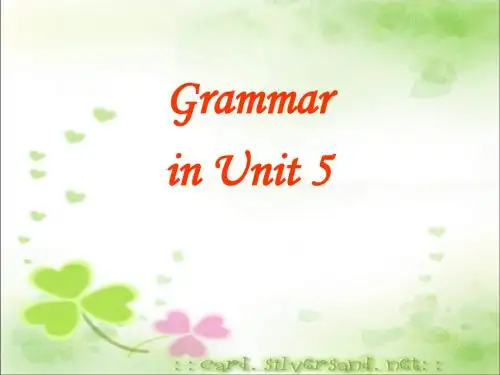

2019-2020学年上学期高二英语选修六导学案 1 复习v–ing 形式作状语 【学习目标】 1. Instruct the students to review the usages of V-ing form as adverbial 2. Deal with the relative exercises 3.Enable the students to learn to cooperate with each other 【课前预习】 一、 动词ing形式的时态、语态及意义
动词 形式 意义
以do 为例
一般式 __________
主动式___________ 与句子主语构成逻辑上的主谓关系,与谓语动作同时发生,或
基本上同时发生
被动式___________ 与句子主语构成逻辑上的动宾关系,且与谓语动作同时发生
完成式 __________
主动式 __________ 与句子主语构成逻辑上的主谓关系,发生于谓语动作之前 被动式 ________________ 与句子主语构成逻辑上的动宾
关系,发生于谓语动作之前
二、V-ing形式作状语,可以表示时间、原因、结果、条件、让步、行为方式、伴随状况等。判断以下句子中的V-ing形式作状语属于哪种? ______ Crossing the road, he was ran over by a car. ______ Not knowing English, he couldn't understand the film. ______ Working hard, you will do well in the exam. ______ Not being a rich man himself, he helped the poor generously. ______ The children went into the classroom, talking and laughing. ______ His parents died in the war, leaving him an orphan. 三、学习v-ing形式作状语的用法时,需要注意以下要点: 1)与过去分词作状语的区别: 一般来说,v-ing形式表示____________; 过去分词表示被动、完成。 The enemy fled in a panic, leaving behind a lot of dead bodies and weapons. Defeated and frightened, the enemy fled in a panic. 2)分词(短语)作状语时,其逻辑主语必须与句子的主语_______。如果不一致,必须用独立主格结构来表示,也就是在分词前加上它的_______________。 ①. Comparing all the great people with each other, you’ll find that they have much in common. ②. The train having gone, we had to wait another day. 3)v-ing形式的否定式:无论在完成式还是被动式里,not必须置于v-ing形式之________。 Not having finished his homework, the boy was still doing it in the classroom. 2019-2020学年上学期高二英语选修六导学案 2 4) v-ing形式(短语)的功能有时相当于一个状语从句。根据这个性质,在使用v-ing形式作状语时,前面可以加上连词。切记:不要在前面或后面的句子前用连词连接。 If working hard , you will make much progress. (改错) Walking on the fallen leaves in autumn, so you’ll feel very comfortable.
5) having done 表示动作发生在主句谓语动作之____; doing 表示动作和主语的谓语动作__________。 Having written the letter, John went to the post office. Seeing the beautiful sight, the children felt excited. 四.有些表示说话人态度的分词结构已成为固定用语,不遵循其逻辑主语与句子一致的原则。在句中独立存在修饰全句,这些短语常见的有: generally speaking 总的来说 judging from/by ... 根据……判断 speaking of 说到…… talking of 谈到…… frankly speaking 坦白地说 considering .../taking ...into consideration考虑到…… seeing ... 考虑到…… providing 如果 supposing 即使;如果
【基础通关】★ 用所给动词的适当形式填空 1.The night________ (come) on ,they started for home. 2.The last bus __________(go), he had to walk home. 3.Time________ (permit), we are going to climb the mountain tomorrow. 4.They are talking with the teacher, their children_______(play) outside. 5.It_______( rain), I went to work with an umbrella. 6.Generally _______(speak), girls are more careful than boys. 7.________(Judge) from his accent, he must be from the north. 8._______(Talk) of travel, have you ever been to Beijing? 9.When _________(cross) the street, please be careful. 10.___________(use)by me now, the bike can’t be lent to you. 11._____________ (see) the movie before, I don’t want to see it again. 12._____________(use)for many years, the bike needs repairing. 句型转换 1. Because he was ill, he didn’t go to school. _______________________, he didn’t go to school. 2. When she was walking along the street one day, she met an old friend of hers. ________________________the street one day, she met an old friend of hers. 3. If it is sunny, we’ll go for a picnic tomorrow. _______________________________, we’ll go for a picnic tomorrow. 4. After she had finished her homework, the little girl began to watch TV. ___________________________her homework, the little girl began to watch TV. 5. Because they had been warned by the teacher, they didn’t make such mistakes. _____________________________by the teacher, they didn’t make such mistakes. 6. As it was a holiday, all the shops were shut. _____________________________, all the shops were shut. 2019-2020学年上学期高二英语选修六导学案 3 7. When he was still a small boy, he went to France with his father. __________________________, he went to France with his father. 8. When autumn comes, swallows go to the south. ___________________, swallows go to the south. 9. That Sam came to school late made his teacher quite angry. __________________________made his teacher quite angry。 10. We have come here in order that we can improve our English. We have come here _________________________________。 11. Since I don’t know her address, I can’t get in touch with her. ___________________________,I can’t get in touch with her。 12. After he closed the windows, he went home. _________________________,he went home。
【合作探究】★★用所给动词的适当形式填空 1. _________________(water) the flowers, he began to cut the grass. 2. We still remember once________________(take) round the famous tower when we were young. 3. ________________(not do) his homework, he stayed at home. 4. He earns a living by ___________ (drive). 5. Precisely____________(speak), they will arrive at 9:20 p. m. 6. ______________________(flood) for several weeks, the city needed food. 7.My ___________ (fall) ill worried my parents. 8. ___________(hear) the news, they all jumped with joy. 9. Our town has dozens of factories, ___________ (include) several shoe factories . 10. The boy was lucky enough to escape _________________ (punish). 11. It’s no use _________________ (try) to make me believe you. 12. The bottle __________________ (contain) the poison was sent to the laboratory. Conclusion 1:V-ing除了_______成分不可作外,还可以作主、宾、表、定、状、